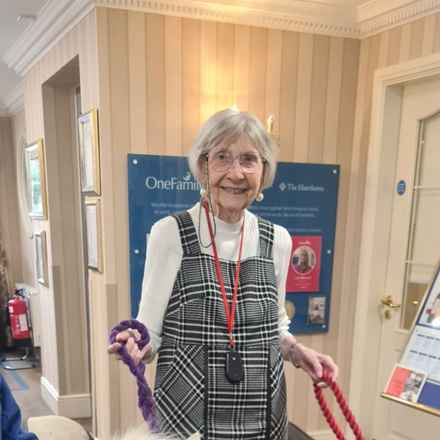"Without speaking a word, my cane tells my story”
Posted: Friday 31 January 2025
For Rita, a simple white stick helped her overcome her embarrassment of losing her sight and helped her communicate her sight loss to others.
At first, she didn't want to use the symbol cane as she hid the extent of her sight loss. Like many, she struggled to accept the changes in her vision. "I didn't want anyone to know that I couldn't see properly," she said. “I did get very embarrassed. When I was out and I had to sign something I'd say things like, I don't see as well as I used to,’ which is complete lie because I could barely see at all.”
Finding support
Rita, aged 87, said: “I didn’t want to use a stick at all. Not at all. I found getting old very difficult, emotionally. When you still feel 20, it’s very hard.”
But her daughter, Lisa started to look around for something that could help her mum. She found the Macular Society online and from there she was directed to her local support group.
“I felt a sense of fear and isolation that was difficult to understand so I decided to do something about it,” Rita said.
“In short, I joined and it was the best thing I ever did. What followed was all due to the help – both practically and emotionally – from the Society.”
Using a cane
Initially Rita had some training to use a long cane, which are designed to help people navigate their surroundings and detect obstacles. After six weeks she was struggling to use it comfortably and asked Lisa to buy a symbol cane instead. The symbol cane is there to show others that a person has a visual impairment.
“I knew as soon as it came that I'd take to it better,” she said. “And I did, because when I go into the town, people are not condescending, they're just nice. People saw my white stick, and without speaking a word, it told my story.”
Giving advice to anyone worried about using a symbol cane, she said: "It’s getting over the fear and the isolation, really. People are very kind to you. I found that with my stick, I don’t have to explain anymore. We start from the basis that I don’t see very well, so I found that good.”
Impact of sight loss
Rita was told she had age-related macular degeneration (AMD) at 85. While her symptoms came on gradually she now struggles to read or watch television.
She said: “The main thing I found hard looking at people's faces, I lost any clarity. I found that if I was with people I knew, they'd never ever age. They'd stay as they were, when I was able to see them. The difficulty I found when I was in company with people I did not realise how much you get from looking at someone.
“You have no indicator at all. It's like speaking to a blank wall. I found that very, very isolating, very lonely.”
Growing in confidence
Rita’s confidence has grown as a result of using the symbol cane, but also after joining her local support group.
“The group helps because it is the mixing with people who have the same problem,” she said. “We swap stories and it's the support of other people which is positive.”
Although Rita has seen the impact of macular disease first hand, she remains determined to not let it hold her back.
She said: “If I can't do something, I keep going. And because of my age, I've got the time, so that's not a problem. I keep going until I can do it. Some things, you have to hold your hands up and say, ‘I can't.’ I mean, it could take me an hour to fasten a button, but now I can write a card and I think, "Well, that's an achievement. I couldn't do that last year."
“So it's just not sitting back and letting it happen. It's not being a victim.”
Find more advice from our members on managing daily life with macular disease
Please see our Daily Living Skills webpage.
Practical tips and advice
Our practical guides cover technology, employment, coping at home, enjoying life out and about, and tips for healthy living, including nutrition.
Support for you
We provide free information and support to those with macular disease, along with their family and friends, to help people keep their independence.




